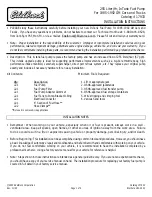
This has been prepared as required of
all manufacturers of passenger cars
under Title 49, Code of U.S. Federal
Regulations, Part 575 pursuant to the
“ National Traffic and Motor Vehicle
Safety Act of 1966’’.
Uniform Tire Quality Grading
Relevant tire grade information on tire
sidewalls.
All passenger car tires must conform to
federal safety requirements. In addition,
consumer information on treadwear,
traction and temperature must be pro
vided.
Consumer Information
The treadwear grade is a comparative
rating based on the wear rate of the tire
when tested under controlled condi
tions on a specified government test
course. For example, a tire graded 150
would wear one and a half (1V
2
) times
as well on the government course as a
tire graded 100. The relative perform
ance of tires depends upon the actual
conditions of their use, however, and
may depart significantly from the norm
due to variations in driving habits, ser
vice practices and differences in road
characteristics and climate.
Traction “A” , “ B” , “ C”
The traction grades, from highest to
lowest, are “A ” , “ B” and “ C” and they
represent the tire’s ability to stop on
wet pavement as measured under con
trolled conditions on specified govern
ment test surfaces of asphalt and con
crete. A tire marked “ C” may have poor
traction performance.
Treadwear
The temperature grades of “A” (the
highest), “ B” and “C” representing the
tire’s resistance to the generation of
heat and its ability to dissipate heat
when tested under controlled condi
tions on a specified indoor laboratory
test wheel. Sustained high temperature
can cause the material of the tire to de
generate and reduce tire life, and ex
cessive temperature can lead to sud
den tire failure. The grade “ C” corre
sponds to a level of performance which
all passenger car tires must meet un
der the Federal Motor Vehicle Safety
Standard No. 109. Grades “ B” and “A ”
represent higher levels of performance
in the laboratory test than the minimum
required by law.
Temperature “A ” , “ B” , “C”
Warning!
The temperature grade for this tire
is established for a tire that is
properly inflated and not over
loaded.
Excessive speed, underinflation,
or excessive loading, either sepa
rately or in combination, can
cause excessive heat build up and
possible tire failure.
Warning!
The traction grade assigned to this
tire is based on braking (straight
ahead) traction tests and does not
include cornering (turning)
traction.
I
115
F
u
el
s,
C
o
o
la
n
ts
,
L
u
b
ri
ca
n
ts
,
et
c.
Summary of Contents for 190 E 2.3 1991
Page 1: ...Mercedes Benz Owner s Manual...
Page 3: ...Mercedes Benz Owner s Manual 1991 190 E2 3 190 E2 6...
Page 13: ...P68 0023 B37C 11 Instruments and Controls...
Page 22: ......
Page 58: ......
Page 76: ......
Page 104: ......
Page 120: ......
Page 121: ...Index...
Page 124: ......
Page 128: ...Mercedes Benz AG Stuttgart Untertuerkheim...
Page 129: ......













































